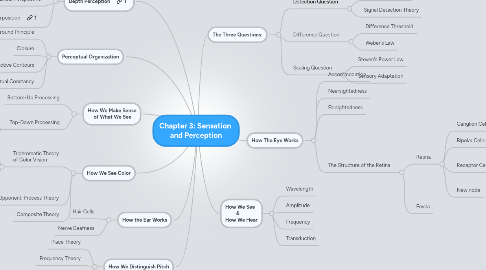Chapter 3: Sensation and Perception
저자: Amberly Shook


1. How We See Color
1.1. Trichromatic Theory of Color Vision
1.1.1. Trichromatic theory
1.1.2. Additive Mixtures
1.1.3. Subtractive Mixtures
1.1.4. Complementary Colors
1.2. Opponent-Process Theory
1.3. Composite Theory
2. How We Distinguish Pitch
2.1. Place Theory
2.2. Frequency Theory
2.3. Composite Theory
2.4. Volley Principle
3. How the Ear Works
3.1. Hair Cells
3.2. Nerve Deafness
4. How We Make Sense of What We See
4.1. Bottom-Up Processing
4.2. Top-Down Processing
4.2.1. Perceptual Set
4.2.2. Contextual Set
5. Perceptual Organization
5.1. Figure-and-Ground Principle
5.2. Closure
5.3. Subjective Contours
5.4. Perceptual Constancy
6. Depth Perception
6.1. Retinal Disparity
6.2. Linear Perspective
6.3. Interposition
7. The Three Questions:
7.1. Detection Question
7.1.1. Absolute Threshold
7.1.2. Signal Detection Theory
7.2. Difference Question
7.2.1. Difference Threshold
7.2.2. Weber's Law
7.3. Scaling Question
7.3.1. Steven's Power Law
7.3.2. Sensory Adaptation
8. How We See & How We Hear
8.1. Wavelength
8.2. Amplitude
8.3. Frequency
8.4. Transduction
9. How The Eye Works
9.1. Accommodation
9.2. Nearsightedness
9.3. Farsightedness
9.4. The Structure of the Retina
9.4.1. Retina
9.4.1.1. Ganglion Cells
9.4.1.2. Bipolar Cells
9.4.1.3. Receptor Cells
9.4.1.3.1. Rods
9.4.1.3.2. Cones
9.4.1.4. New node
9.4.2. Fovea
